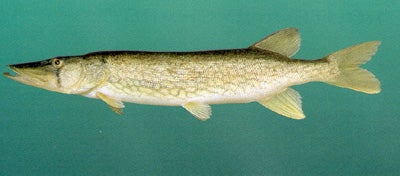SCIENTIFIC NAME:
Esox niger
CHARACTERISTICS:
Like the redfin, the chain pickerel has fully scaled cheeks and gill covers and few, if any, scales on top of the head. The pigmented bar beneath the eye is nearly vertical. The body in cross section is slightly deeper than it is wide. The back is dark green to brown. Sides are marked with greenish, rectangular-shaped patterns that resemble the links of a chain--hence the common name. The venter is either cream or pale yellow. See Lesueur (1818b) for original description.
ADULT SIZE:
15 to 30 in (380 to 762 mm).
STATE RECORD:
a list of the State Record Freshwater Fish.
DISTRIBUTION:
Chain pickerel have been collected in every river drainage except the Yellow and Blackwater rivers in south Alabama. Their apparent absence in headwaters of these drainages is probably due to either lack of preferred habitat or insufficient sampling.
HABITAT AND BIOLOGY:
Chain pickerel prefer large streams, rivers, reservoirs, and swamps where there is minimal flow and substrates consist of silt and mud. This efficient predator lies motionless along the margins of aquatic vegetation or undercut banks. This species is a spring spawner. Young at first remain in schools; as they grow older, they become solitary hunters. As with the redfin pickerel, the adult diet consists of aquatic insect larvae, crayfishes, and sunfishes, especially bluegill. Crossman (1978) reports a maximum life span of nine years.
REMARKS:
Anglers catch chain pickerel (locally known as “jack”) in oxbow lakes, reservoirs, and swamps. It is an excellent game fish that jumps repeatedly when hooked.
ORIGINAL DESCRIPTION:
Lesueur described the chain pickerel in 1818.
ETYMOLOGY:
Esox means pike.
Nigermeans black.
This copyrighted information is from the Fishes of Alabama and the Mobile Basin.






